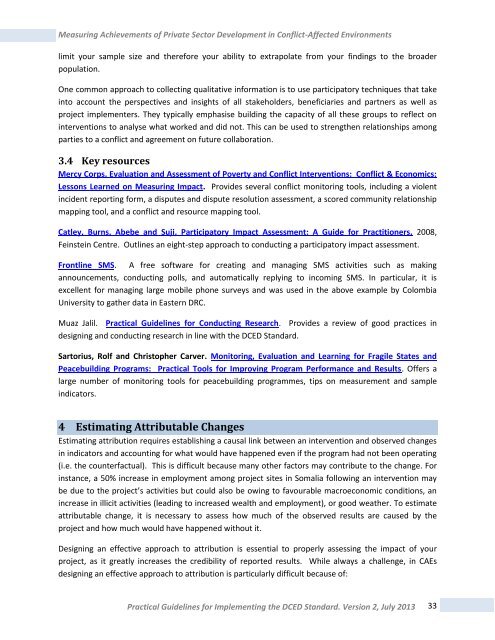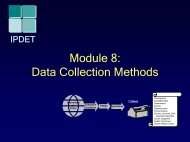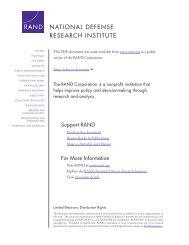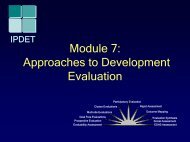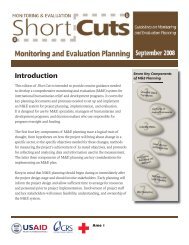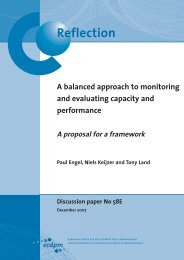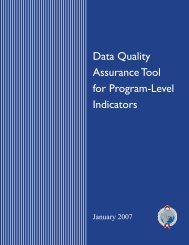Measuring Achievements of Private Sector Development in ... - DCED
Measuring Achievements of Private Sector Development in ... - DCED
Measuring Achievements of Private Sector Development in ... - DCED
You also want an ePaper? Increase the reach of your titles
YUMPU automatically turns print PDFs into web optimized ePapers that Google loves.
<strong>Measur<strong>in</strong>g</strong> <strong>Achievements</strong> <strong>of</strong> <strong>Private</strong> <strong>Sector</strong> <strong>Development</strong> <strong>in</strong> Conflict-Affected Environments<br />
limit your sample size and therefore your ability to extrapolate from your f<strong>in</strong>d<strong>in</strong>gs to the broader<br />
population.<br />
One common approach to collect<strong>in</strong>g qualitative <strong>in</strong>formation is to use participatory techniques that take<br />
<strong>in</strong>to account the perspectives and <strong>in</strong>sights <strong>of</strong> all stakeholders, beneficiaries and partners as well as<br />
project implementers. They typically emphasise build<strong>in</strong>g the capacity <strong>of</strong> all these groups to reflect on<br />
<strong>in</strong>terventions to analyse what worked and did not. This can be used to strengthen relationships among<br />
parties to a conflict and agreement on future collaboration.<br />
3.4 Key resources<br />
Mercy Corps, Evaluation and Assessment <strong>of</strong> Poverty and Conflict Interventions: Conflict & Economics:<br />
Lessons Learned on <strong>Measur<strong>in</strong>g</strong> Impact. Provides several conflict monitor<strong>in</strong>g tools, <strong>in</strong>clud<strong>in</strong>g a violent<br />
<strong>in</strong>cident report<strong>in</strong>g form, a disputes and dispute resolution assessment, a scored community relationship<br />
mapp<strong>in</strong>g tool, and a conflict and resource mapp<strong>in</strong>g tool.<br />
Catley, Burns, Abebe and Suji, Participatory Impact Assessment: A Guide for Practitioners, 2008,<br />
Fe<strong>in</strong>ste<strong>in</strong> Centre. Outl<strong>in</strong>es an eight-step approach to conduct<strong>in</strong>g a participatory impact assessment.<br />
Frontl<strong>in</strong>e SMS. A free s<strong>of</strong>tware for creat<strong>in</strong>g and manag<strong>in</strong>g SMS activities such as mak<strong>in</strong>g<br />
announcements, conduct<strong>in</strong>g polls, and automatically reply<strong>in</strong>g to <strong>in</strong>com<strong>in</strong>g SMS. In particular, it is<br />
excellent for manag<strong>in</strong>g large mobile phone surveys and was used <strong>in</strong> the above example by Colombia<br />
University to gather data <strong>in</strong> Eastern DRC.<br />
Muaz Jalil. Practical Guidel<strong>in</strong>es for Conduct<strong>in</strong>g Research. Provides a review <strong>of</strong> good practices <strong>in</strong><br />
design<strong>in</strong>g and conduct<strong>in</strong>g research <strong>in</strong> l<strong>in</strong>e with the <strong>DCED</strong> Standard.<br />
Sartorius, Rolf and Christopher Carver. Monitor<strong>in</strong>g, Evaluation and Learn<strong>in</strong>g for Fragile States and<br />
Peacebuild<strong>in</strong>g Programs: Practical Tools for Improv<strong>in</strong>g Program Performance and Results. Offers a<br />
large number <strong>of</strong> monitor<strong>in</strong>g tools for peacebuild<strong>in</strong>g programmes, tips on measurement and sample<br />
<strong>in</strong>dicators.<br />
4 Estimat<strong>in</strong>g Attributable Changes<br />
Estimat<strong>in</strong>g attribution requires establish<strong>in</strong>g a causal l<strong>in</strong>k between an <strong>in</strong>tervention and observed changes<br />
<strong>in</strong> <strong>in</strong>dicators and account<strong>in</strong>g for what would have happened even if the program had not been operat<strong>in</strong>g<br />
(i.e. the counterfactual). This is difficult because many other factors may contribute to the change. For<br />
<strong>in</strong>stance, a 50% <strong>in</strong>crease <strong>in</strong> employment among project sites <strong>in</strong> Somalia follow<strong>in</strong>g an <strong>in</strong>tervention may<br />
be due to the project’s activities but could also be ow<strong>in</strong>g to favourable macroeconomic conditions, an<br />
<strong>in</strong>crease <strong>in</strong> illicit activities (lead<strong>in</strong>g to <strong>in</strong>creased wealth and employment), or good weather. To estimate<br />
attributable change, it is necessary to assess how much <strong>of</strong> the observed results are caused by the<br />
project and how much would have happened without it.<br />
Design<strong>in</strong>g an effective approach to attribution is essential to properly assess<strong>in</strong>g the impact <strong>of</strong> your<br />
project, as it greatly <strong>in</strong>creases the credibility <strong>of</strong> reported results. While always a challenge, <strong>in</strong> CAEs<br />
design<strong>in</strong>g an effective approach to attribution is particularly difficult because <strong>of</strong>:<br />
Practical Guidel<strong>in</strong>es for Implement<strong>in</strong>g the <strong>DCED</strong> Standard. Version 2, July 2013<br />
33


